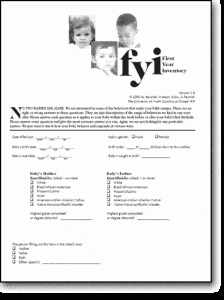
The International Journal of Research & Practice has published a study that finds 31% of children categorized as at risk for autism spectrum disorders (ASD) at 12 months are diagnosed with ASD by age three and that 85% of children at risk for ASD had some other developmental disability or concern by three years of age.
For the study, researchers at University of North Carolina School of Medicine, looked at results from the First Year Inventory, a parent-report questionnaire developed as a screening tool to identify infants who might be at risk for developmental disorders.
The FYI covers two broad developmental domains — social communication and sensory regulatory functions. The two domains are further defined by 8 specific constructs: social orienting and receptive communication, social-affective engagement, imitation, expressive communication, sensory processing, regulatory patterns, reactivity, and repetitive behavior. The 63 items on the FYI are based upon the empirical literature related to early symptoms of ASD, as well as our team’s retrospective video analysis research of infants at 9-12 months of age who later received a diagnosis of ASD, and prospective validation studies of diagnostic outcomes in infants at one year of age.
Parents of 699 children filled out the survey when their child was 12 months of age and again when their child was 3 years old. Further in-person evaluations were encouraged for children who were identified as at risk for ASD.
Grace Baranek, Ph.D., an autism researcher with the Program for Early Autism, Research, Leadership and Service (PEARLS) in the Department of Allied Health Sciences at the UNC School of Medicine, explained:
“These results indicate that an overwhelming majority of children who screen positive on the FYI indeed experience some delay in development by age three that may warrant early intervention.”
Lauren Turner-Brown, Ph.D., also a researcher with PEARLS and the Carolina Institute for Developmental Disabilities, said:
“Identification of children at risk for ASD at 12 months could provide a substantial number of children and their families with access to intervention services months or years before they would otherwise receive a traditional diagnosis.
These findings are encouraging and suggest promise in the approach of using parent report of infant behaviors as a tool for identifying 12-month-olds who are at risk for an eventual diagnosis of ASD.”






